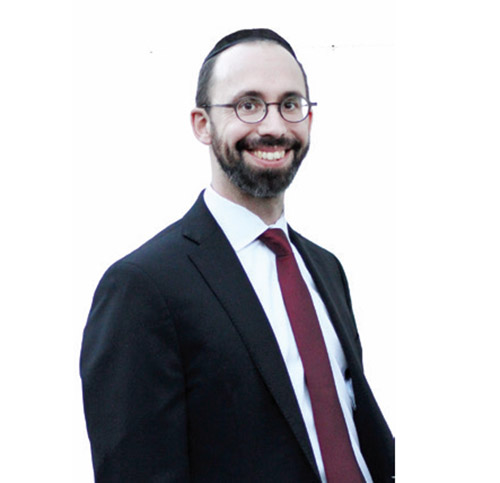
This past week, I drove my car to the mechanic and a friend followed me so he could drive me back home. On my way, I noticed a small side street that looked like a shortcut, so I took it. Driving down the small block, something didn’t feel quite right. Suddenly, a car pulled up alongside me and the driver rolled down his window and wagged his finger at me. Then it all came together: I was driving down a one-way street in the wrong direction! Of course, all this time my friend was following right behind me the wrong way on this one-way street! I thought to myself, “It’s incredible how people will follow someone they trust implicitly—even when it’s in the wrong direction.”
One of the last mitzvos in the Torah is in Parshas Re’eh, “You shall follow after God… and to Him you shall cleave.” (13:5)
Certainly, following after Hashem will only lead us in the right direction. But, how does one follow after Hashem, Who is infinite and has no physical manifestations? The Gemara (Sotah 14a) explains: you shall follow after Hashem’s qualities—just as Hashem clothed Adam and Chava, so too we should ensure people have clothes to wear. Just as Hashem visited Avraham Avinu when he was sick after his bris mila, so too we should visit the sick….
And how do we “cleave to Hashem”? Interestingly, Rashi uses the above Gemara, which talks about mirroring Hashem’s qualities, to explain how to cleave to Hashem!
Why does Rashi use this Gemara to explain this mitzvah of clinging to Hashem when clearly the Gemara is explaining the mitzvah of following after Hashem? Rav Aharon Kotler, zt”l, explains that Rashi is giving us an entirely new perspective on compassion and caring for others. “Kirvas Elokim li tov, Closeness to God is what’s good for me,” (Tehillim) says David Hamelech.
Think about it. Who does not want to get close to Hashem? Yet, how do we do that? Initially, we might think of tefillah—prayer—or Torah study, which is an excellent start. When it comes to chesed, we view it as a very important mitzvah, but not as a mitzvah that unites us with Hashem Himself, as Torah and tefillah help us do. Yet, from this Rashi, we see that simple acts of caring for others constitute clinging to Hashem… literally. Even the small talk needed to make a person feel important and cared for, not to mention picking up an item at a supermarket for your neighbor, or visiting the sick, or listening to what’s bothering someone… all these constitute clinging to Hashem Himself, just as much as Torah and tefillah. This is precisely why Rashi quotes this Gemara on the mitzvah of clinging to Hashem; because by performing the mitzvah of following after Hashem’s ways, we then are clinging to Hashem Himself.
As this Shabbos is Shabbos Mevarchim of the month of Elul, I am reminded of a story that illustrates this point.
It was the eve of Yom Kippur. The whole town was in shul for Kol Nidrei. The rabbi concluded his impassioned plea for everyone to do teshuva, and the chazan was ready to start Kol Nidrei. Unexpectedly, at this momentous time, the rav turned to a close shul member and said, “Come with me.” They walked out of the shul and kept going until they reached one of the homes at the far end of town. The rav knocked on the door. A 12-year-old girl answered the door. She looked weak and ill. “How do you feel?” asked the rav. “I feel weak,” said the girl. “Refuah Shleima. I want to wish you a gmar chasima tova. Tell me… did you get a new dress for Yom Tov?” asked the rav. “I did, but I feel so weak that I haven’t even been thinking about the dress,” replied the girl. “Can you tell me what your dress looks like?” asked the rav. “Well, it’s pink and has ribbons on the sleeves….” The girl continued to describe the dress in great detail. Incredibly, the girl’s spirits seemed to perk up as she was talking and color started coming back to her cheeks. “I can even show it to you,” added the girl. She then ran to get the dress and showed it to the rav. At this point, the girl looked much healthier. “It’s beautiful… the perfect Yom Tov dress! I want to wish you a sweet year,” said the rav, and with that he went back to shul, having accomplished his goal before Yom Kippur.
Small talk. Showing interest and compassion. Chesed. That is the way Hashem wants us to cleave to Him.
By Rabbi Baruch Bodenheim
Rabbi Baruch Bodenheim is the associate rosh yeshiva of Passaic Torah Institute (PTI)/Yeshiva Ner Boruch. PTI has attracted people from all over northern New Jersey, including Teaneck, Bergenfield, Paramus, Rockaway and Fair Lawn. He initiated and continues to lead a full multi-level gemara learning program in the evenings, gives halacha and hashkafah shiurim on Shabbat and, more recently, has spread out beyond PTI to begin a weekly Beit Medrash program with in-depth chavruta learning in both Livingston and Springfield.










